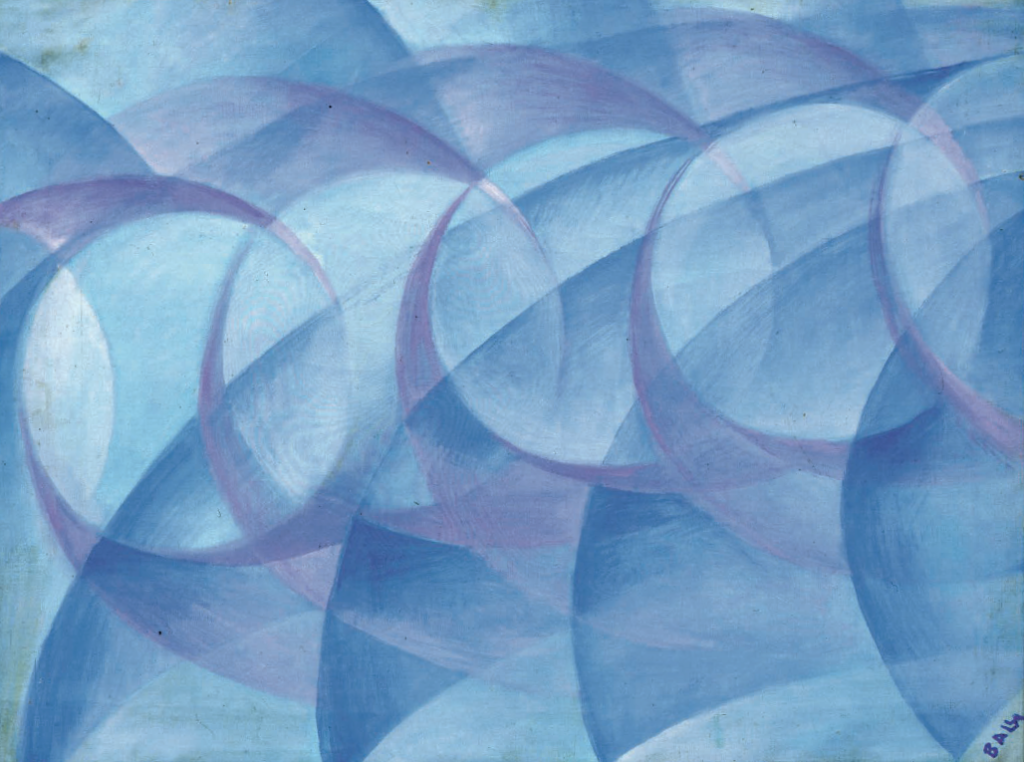Velocità astratta
Abstract Speed
Artist Giacomo Balla
1913
Accession year 2005
Oil on canvas, 76.7 x 108 cm
Signed on the front, bottom left: “FUTUR BALLA”; inscription on the back, centre: “velocità astratta G. Balla Roma 1913”
Collection Fondazione Francesco Federico Cerruti per l’Arte
Long-term loan Castello di Rivoli Museo d’Arte Contemporanea, Rivoli-Turin
Inv. no. CC.13.P.BAL.1913.A64

“No longer a matter of trajectories encapsulating a path or simultaneity of viewpoints therefore […] but rather a new artistic formulation of dynamic space”.
(Giorgio de Marchis, 1977)
Provenance: Casa Balla, Rome; Campilli Collection, Rome (1960-89).
Exhibitions: Paris 1957 (no. 2); Winterthur 1959 (no. 2); Venice 1960 (p. 13 cit.; no. 2); Paris 1960-61 (p. 15, no. 5); Rome 1971 (pp. 13-15); Rome 1980 (pp. 24-25); Venice 1986 (p. 76); Paris 1992; New York 1993; Berlin 1997 (no. 20); Cortina d’Ampezzo-Prato-Milan 2000 (p. 76, no. 13); Rome 2002 (pp. 60, 62 ill.); Vienna 2003 (p. 146, no. 31); Turin 2006 (p. 10 ill.); Milan 2008 (pp. 94-95); Mamiano di Traversetolo 2015 (p. 127, pl. 15, no. 15); Alba 2016-17 (p. 140).
Bibliography: Drudi Gambillo, Fiori 1958-62, no. 72; Ballo 1973, p. 242 cit., no. 189; Tisdall, Bozzolla 1977, p. 68, no. 62; Turin 1980b, p. 121, ill.; Lista 1982, p. 191, no. 298; Gucciardi 1992, p. 36, ill.; Gigliotti 2002, p. 38, ill.; The Cerruti Collection 2019, p. 41, ill.
Giacomo Balla intensified his work on the representation of movement during 1913, adding the depiction of speed to the kinetic dynamism of the succession of steps of a little girl running along a balcony and the aerial trajectories of swallows. The works of this new series, comprising over twenty canvases as well as countless sketches and studies, focus on the automobile as a visual metaphor of technological progress, a symbol of the new beauty and the Futurist cult of modernity. As always, Balla’s starting point was the observation of reality, documented in the sketchbooks of the period by repeated drawings of cars and mechanical movement. The birth and development of this theme can be traced in the artist’s recollection of when he “freed himself from the burden of experience” and began, “in the middle of a large, empty, dazzling white room […] to draw the lines of racing cars on sheets of paper, first objective and then synthetic (the synthetic line of speed), fundamental and formidable cornerstones of extremely personal thought-forms, his own indisputable creations”.1
While the early works on the dynamism of racing cars still display traces of descriptive and formal elements that identify the shape of the vehicle, the driver and the surrounding landscape, the later ones eschew all figurative reference in favour of “dynamic successions, abstract speed, artistic equivalents of speeding light”.2 The aim of this process is to destroy the immobility of all things, swept up in the chaos of universal dynamic action: “No longer a matter of trajectories encapsulating a path or simultaneity of viewpoints therefore […] but rather a new artistic formulation of dynamic space”.3 Light and movement thus become the essential components, capable in their combined action of dematerialising bodies completely, as called for in the technical manifesto of Futurist painting of 1910.
The painting marks an important stage in Balla’s work on the dynamism of mechanical bodies and the perceptual and sensory changes generated by motion in the vision of the physical phenomenon. The very title already refers to the concepts of abstraction and speed that Balla was to address constantly all through 1913 and 1914, culminating in a system of symbolic diagrams that capture the abstract essence of objective reality. There is practically no colour. All the dynamic tension is orchestrated by bold monochromatic contrasts and metallic light. The subject, a car at high speed, is now an almost completely unrecognisable interplay of soaring, curved lines that fragment and multiply its forms, transmuted into pure graphic marks. The rhythm of acceleration is cadenced by the progression of sweeping curves propagated for the entire length of the painting and small vortices that translate the movement of the wheels. Space also undergoes modification, completely integrated into the momentum of dynamic acceleration as part of it.
Before being purchased by Francesco Federico Cerruti, thanks to intermediation from Claudia Gian Ferrari, the work was owned by the politician Pietro Campilli, introduced to the Balla family in the late 1950s by Laura Maria Drudi Gambillo, a great expert on Futurism and joint author with Teresa Fiori of the Archivi del Futurismo, one of the most important contributions to systematic study of the avant-garde movement.
[Zelda De Lillo]
1 Balla 1984, p. 304.
2 Ibid., p. 290.
3 De Marchis 1977, p. 33.

